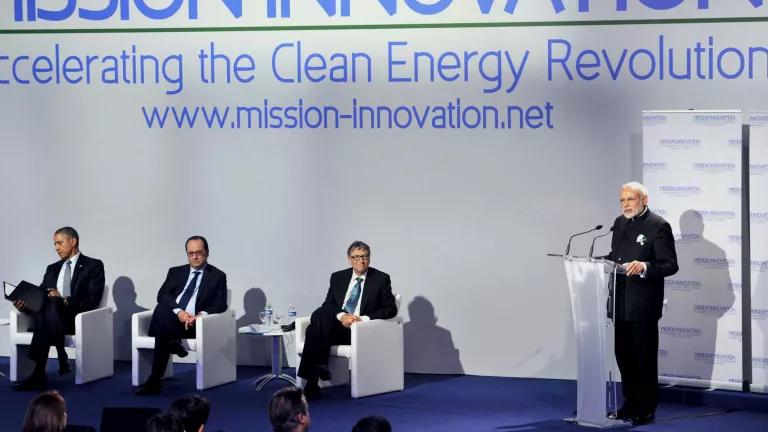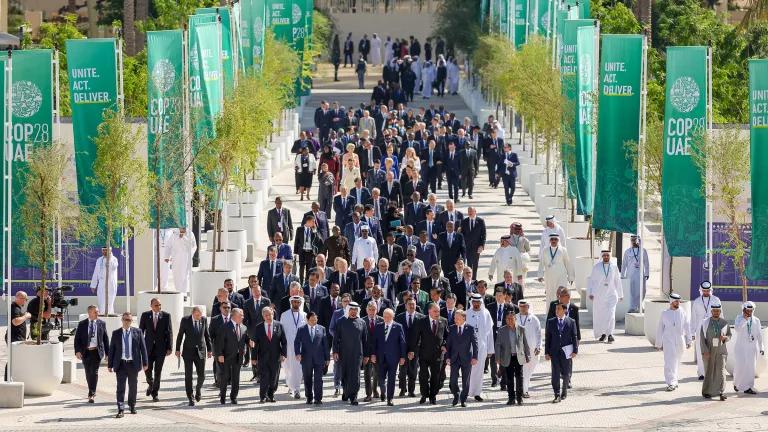Head Start in Paris: India Launches International Solar Alliance on Inaugural Day of Climate Talks

Prime Minister Modi addressing the Innovation Summit during COP21 in Le Bourget, France, on November 30, 2015
Prime Minister's Office, Government of India
Indian Prime Minister Narendra Modi and French President François Hollande, along with world leaders, launched the International Solar Alliance on the inaugural day of the U.N. Climate Summit in Paris today. The solar alliance brings together key countries and invites over 100 solar-rich countries to propel clean energy and protect the climate. The cooperation demonstrated by both developed and developing countries in launching the solar alliance gives a head start to the collective, flexible cooperation needed to hammer out an international agreement in Paris to sustainably and effectively fight climate pollution.
"We must turn to solar to power our future," urged Prime Minister Modi in launching the International Solar Alliance. President Hollande praised India's leadership and called for France and others to mobilize finance and technology to achieve climate justice during the summit. Indian Power Minister Piyush Goyal explained, "We share collective ambition to take innovative, concerted efforts to reduce the cost of finance and technology for solar energy."
The International Solar Alliance invites countries located between the Tropics of Cancer and Capricorn to join, including many African and Asian nations, Australia, New Zealand, Brazil, France, China and the United States. Prime Minister Modi estimates $100 billion will be needed annually by 2020 to finance the clean power initiative. India's National Institute of Solar Energy will lead the coordination of the solar alliance initiative for the first five years. The International Solar Alliance is part of India's effort to advance a low-carbon economy, including domestic targets to install 100 gigawatts of solar energy by 2022. Prime Minister Modi also marked India's progress, noting that India's current installed solar energy capacity of 4 gigawatts will jump to 12 gigawatts by the end of 2016.
Key features of the International Solar Alliance
- Collaborate on research and development of new and affordable solar energy technologies
- Share regulatory and policy frameworks
- Exchange best practices for solar energy development and installation
- Promote joint efforts and programs to train a skilled workforce
- Cooperate on common industry standards
- Partner on attracting financial investments and creating innovative financing mechanisms
The launch of the International Solar Alliance shows the flexibility and cooperation needed at the negotiations to achieve a strong agreement to reduce global warming pollution. In applauding India for its innovation and leadership in solar energy, UN Secretary General Ban Ki-moon urged leaders to take even great action this week and to come together to protect our planet and fight climate change.
"We cannot waste any more time. Let's meet in the middle. All countries must be part of the solution."
Secretary General Ban Ki-moon
NRDC's full statement is available here.
Following is a statement by Rhea Suh, President of the Natural Resources Defense Council:
"This unprecedented international solar collaboration sets an encouraging tone as country representatives gather today to reach a new global climate agreement. India's leading role in forming an International Solar Alliance anchors its own climate commitment to ramp up renewable energy. It also has the potential to propel international solar markets forward, all while fighting climate change, improving global health and boosting economies."
Following is a statement by Anjali Jaiswal, India Initiative Director for the Natural Resources Defense Council:
"Coupled with its comprehensive solar program aiming to reach 100 gigawatts by 2022, India has once again positioned itself as a global leader in clean energy. The International Solar Alliance aims to expand solar power primarily in countries that are resource-rich but energy poor, where clean energy solutions are most needed. Developing affordable solar technologies and attracting the considerable investment required to finance the envisioned solar transition are critical steps to support India and other countries to achieve their ambitious clean energy goals set as part of the Paris negotiations."
Following is a statement by JingJing Qian, China Program Director for the Natural Resources Defense Council:
"As the world's solar market leader, China has much to offer and can benefit greatly from its participation in the International Solar Alliance. China has pledged to cap its carbon emissions within 15 years, primarily through transitioning to solar and wind energy to power its development. With the U.S. and China joining India, along with over 100 other nations, to support this solar alliance on the first day of the UN climate negotiations, the majority of greenhouse gas emitters are demonstrating tremendous leadership to develop sustainably while curbing climate change."
Following is a statement by Dr. Arunabha Ghosh, CEO of the Council on Energy, Environment and Water:
"The launch of the International Solar Alliance (ISA) is a historic step for global cooperation and a much needed boost for a low-carbon future. Under India's leadership, the ISA could inspire and support several developed and developing countries to advance on a clean energy pathway by lowering financing costs, developing common standards, encouraging knowledge sharing and facilitating R&D collaborations and co-development of technologies to meet the Sustainable Development Goals (SDGs) announced earlier this year. India has emerged as the natural leader for this alliance, with its ambitious targets to install 175 GW of renewable energy by 2022, and non-fossil fuel electricity generating systems accounting for 40% of the cumulative installed capacity by 2030."



